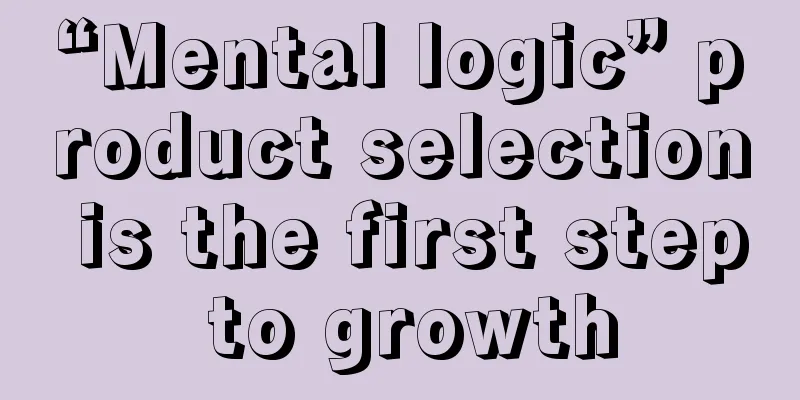“Mental logic” product selection is the first step to growth

It is a consensus that we will enter the stock economy in 2023, and the traffic-oriented era has entered an inertial decay cycle. The underlying logic of growth has changed from "traffic is king" to "the world's martial arts, only accuracy is invincible", because it is not about doing it fast or doing it more, but doing it accurately that can guarantee deterministic growth. Assuming that there is no problem with brand positioning, the first step to accuracy is to choose the right product. Only when the product is accurate, can the subsequent planting and conversion have a deterministic growth return. 1. Product selection is difficult, as difficult as climbing to heavenI recently chatted with friends from brands and found that most of them have pain points in product selection. Putting aside supply chain and channel issues, the probability of achieving expectations through traditional product selection is getting lower and lower. In particular, the marketing department, which is mainly responsible for back-end marketing and communication, feels powerless in the post-product selection link. The powerlessness comes from the fact that the marketing department can only promote the products that have been decided. If the products are not decided accurately, they will encounter two major problems: "hard market failure" and "no promotion, no performance". "Forcibly smashing the market" may be because the product is not accurately defined and does not hit the market and consumer demand, so it is difficult to leverage natural traffic, and the CPM, CTR, etc. will be high. "Stop spreading, stop performance" is because the product itself does not hit the user's mind, and hard promotion may increase some GMV. But once the spread stops, users will turn to topics and products that are more attractive to them, and the product that hits the market hard will decline precipitously. Therefore, there is a saying in the market: "Product selection is as difficult as climbing to the sky." It is already 2023, BI, intelligent analysis, and big models have emerged, so why is product selection so difficult? 2. The original product selection is "restaurant logic"Everyone must be familiar with product selection. In digital retail (e-commerce), the product selection logic of most brands is "restaurant logic". How to understand this? If you compare your online business to a roadside restaurant, common sense tells you that in order to do good business, you need to set aside at least 4 dishes. 1. Traffic-generating/hot-selling productsDishes that can attract customers to your restaurant must be cost-effective, and it is best if there are many customers who have just needed and liked the dishes, and there are many repeat purchases. Most of the publicity is also to promote the popular items, such as the original chicken of Kaifeng cuisine, and the small brown bottle and small black bottle in beauty products. Brands doing business online also need big single products that attract customers or popular items. 2. Profit paymentAfter attracting customers to the store, some dishes can have high gross profits, but only those who are willing to take the bait will be tempted. The profit margins of brand online business are based on the same underlying logic. Profit margins are generally weakly promoted or promoted in the early stage of listing and at key nodes to make money quietly. 3. Try new stylesFor a restaurant to do well in business, it needs not only new customers but also old customers to come and keep them fresh, so it needs to have new and unique dishes that are not often seen on the market and that will make people want to come to the restaurant (some dark cuisine dishes play with this). This corresponds to the fact that new products often appear in brand selection, and new products are very important growth and repeat purchase drivers. 4. PackageIt is not enough to sell the best-selling dishes well. It is better to pair them with some dishes that are not selling well, so as to increase the customer orders. This is why we need set meals. Set meals can lock customers' wallets. If they buy my set meal, they will have no money to eat at restaurants around me. Therefore, there are many brand packages in digital retail e-commerce, in order to increase customer orders, increase GMV, try out or block competitors, clear inventory, etc. When selecting products, restaurants usually only consider their own financial flow data and customer data, and select products that attract customers, make profits, try new products, and set meals, without fully considering a wider range of user insights. Usually, the marketing department does not fully participate in the early product selection. After selecting products, the marketing department takes over the latter part of marketing communication, which leads to the two major pain points of "hard market attack" and "no communication, no performance". If it is not "restaurant logic", what logic should it be? Before revealing the answer, please read further: Further reading 1: A good helper for selecting products/new products: "Behavioral Data Science" There is an uncertainty principle in physics, which means that you need to use one particle to collide with another particle to get feedback data. However, when you use one particle to collide with another particle to try to measure the speed, you are actually interfering with the measured particle, so the result is not the original speed, which is unmeasurable. There is a famous principle in psychology that people are very complicated, and it is difficult to judge people's reactions before they see something they have never seen before. So you will find that using traditional research (focus group, 1 on 1) to obtain users' reactions to a new product is often less and less accurate in the real world. Because you ask questions to get users to respond, first, it is inefficient. It takes at least 4 to 6 weeks from brief to insights from a survey. Second, he/she will be influenced by the environment, the questions, and the person asking the questions. Third, he/she will give answers through imagination, and this process is mixed with a lot of rational judgment. But people are very emotional animals. He/she says he/she will buy it, but he/she may not buy it in the real environment. Unless you completely restore the usage scenario without any interference with the user, just observe, but this approach is very costly and inefficient. In the digital retail world, because of big data, the law of "behavior doesn't lie" has emerged. Because the human mind is completely externalized in behavior, user behavior in digital retail leaves a mark, and this law can be applied to new products/product selection. Use “behavioral data science” to support product selection/new products. When the amount of products with attribute A purchased by users across the globe is increasing rapidly, it means that products with attribute A are becoming more and more popular; when users across the globe are increasingly reading the content of products with attribute A and discussing attribute A more, it means that products with attribute A are becoming more and more popular. In addition, in the rules of big data (full sample data), we can see the stage of global user behavior, whether it is in the early rising stage, the late rising stage, the flat stage or the declining stage, which is of great significance to new products/product selection. Generally speaking, the best guess is the early rising stage, and never step into the declining stage. 3. Correct product selection is mental logic"Mental logic" is a product selection logic that takes the user's mind into consideration based on "restaurant logic". If your brand needs market communication, you must consider the product selection logic. Take a restaurant as an example. You run a restaurant for a while. At first, the business is OK, but then you find that the customers are getting fewer and fewer, the average customer spending is getting lower, and the profit is getting thinner and thinner. The restaurant next door is doing better and better, so you get anxious and emo. At this time, you find that you can't just look at your financial flow and your customer base analysis ; fortunately, your good friend reminds you to look at what the customers in your area like to eat, what they like to talk about, and what is popular and what is the future trend. You also want to know what customers in your area are increasingly craving for? The problem is that you can’t send people to all the restaurants near you to see what others are doing, what customers are ordering, and what customers say after eating. But you are smart because you remember there is an app called Zhongdianping, where you can go to see what dishes other restaurants in your neighborhood are promoting, and you can also see users’ comments on the store. Then you suddenly have an idea, and use "Zhongdian.com" to understand what hot dishes (traffic-generating dishes/explosive dishes) are in this area , and what dishes/selling points customers are talking about. Next, you redesign the traffic-generating dishes/explosive dishes , and collide the candidate dishes determined by "restaurant logic" with the hot dishes in the area and the hot topics discussed by customers on Weibo, Douyin, Xiaohongshu, etc. For example, you launched a fan-exclusive package at a BOYS concert, and came up with a new traffic-generating dish/explosive dish, and tried a new one. From then on, the business got better and better, and you and the restaurant lived happily together, The End. Mental logic product selection is based on big data to understand what product attributes users in your segment like more and more (note which attributes are selling better and better) and what product attributes users are talking about more and more. Then anchor on the product attributes in the rising period (selling better and better, more people are talking about it), combined with the data of "restaurant logic", to comprehensively analyze and determine the product selection. Pay special attention‼ ️The mental product selection logic is the thinking logic of global growth . If it is a separate self-closed loop field, such as a certain Duoduo product selection, such as a certain group product selection, because there is no need to consider spillover situations, it may be possible to complete it using the platform's own product selection strategy tools. 4. In practice, how to use mental logic to select products?I would like to clarify that "mental logic" cannot be used alone, but needs to be used in combination with "restaurant logic" data. Because marketing communications usually focus on traffic-generating/hot-selling and early adopters, I will now talk about the usual steps of mental logic product selection for these two types of products, especially the process that the marketing department needs to pay attention to. 1. Selection of traffic-generating/hot-selling productsAnalyze the "Restaurant Logic" data (one-party data): The first step is to run the "restaurant logic" data to obtain a short list of alternative traffic-generating/explosive products by cross-analyzing financial data and its own population data. Insight into attribute trends (third-party data): The attribute trend here refers to the product attributes, which require the integration of social media data and e-commerce data. In social media content, use structured content tags to find the product attributes that are popular in your sub-track; in e-commerce data, use structured product attribute analysis to find the product attributes that are popular in your sub-track. Use matrix analysis to obtain the product attributes that are both popular and well-received. Further reading 2: Product attributes in content In digital retail, attributes are the product track, because only when the attributes in the rising period are done right can the product grow. Whether it is planting grass or bringing goods, there are product attribute labels in the content, such as posts on Xiaohongshu and short videos on Douyin. For example, the "Morning C and Late A" that was first planted on Xiaohongshu is a product attribute label. After planting grass for a period of time, this attribute label will also appear on Douyin, and after a while, it will also appear on Tmall and JD's product titles and details pages. This is why the product attributes in the content can travel from social media to e-commerce, and then travel from e-commerce to retail terminals, from single-point breakthroughs to integrated marketing. Understanding the attributes of products that can travel is very meaningful for brands, because in this way, you can measure which product attributes are trending in social media content and e-commerce, which can serve as an important basis for product selection. The short list of "traffic-generating/explosive items": Now that you have the "popular" product attribute, you need to collide it with the short list in "restaurant logic". There are two situations: Type 1: If there is a corresponding "popular" product attribute in the "restaurant logic" shortlist, directly select the corresponding product, or select a product with a higher overlap The second type: There is no corresponding "popular" product attribute in the "restaurant logic" shortlist. This is possible. Don't be EMO at this time, it may be an opportunity! The correct approach is to re-select products and see if there are any "popular" product attributes among all your products. Seriously consider promoting products with "popular" attributes, because the success probability of this product is higher. The judgment of "popular" is seen from behavioral data. Remember? Behavior does not lie. (Special note: If you don't hit the known drainage/hot-selling products with "popular" attributes, don't give up and keep them. It is recommended to make them into set meals to increase customer orders.) Determine your content strategy: Why do we need to set a content strategy when selecting products? Because if the content is not good, no one will read it, and no matter how good the product is, it will not produce sales. Fortunately, when selecting products, the attributes are determined, so the attribute selling points in content marketing are already determined. At the same time, through the analysis of structured content tags, we can know the industry tags that match this attribute tag, such as character setting, scene, plot (if there is a short video), etc. In this way, the content for this product is also determined. Determining the product is to determine the content direction. 2. Try new productsList all the new styles in "Restaurant Logic" (Yifang Data) Generally speaking, there is not much room for "restaurant logic" to try new products, because the research and development of new products takes time, so in this step all the new products that can be used in the bottom of the box are taken out, and then they are compared with the database. Insight into “new” attribute trends (third-party data) The basic analysis method here is the same as the principle of traffic-generating/hot-selling products, so I will not go into details. There are two differences: First, the attributes here must be newly emerging attributes, or attributes that do not appear on a large scale in your sub-track. Second, the attribute of "well-received growth rate" being greater than "popular growth rate" has a higher priority, because it means that users like this attribute very much, but the supply side is still insufficient, which means that new products with insufficient supply have the upper hand. Hit the "try new" short list You have new product attributes in third-party data, which need to be collided with the short list in your own data. There are two situations: The first method: If there are corresponding "popular" new product attributes in the "try new products" shortlist, directly select the corresponding product, or select a product with a higher degree of overlap. The second type: There is no corresponding "popular" new product attribute in the "try new products" shortlist. This is entirely possible. At this time, it is strongly recommended not to spend money to promote these new products, but to find new products with the closest good attributes and conduct regular exposure. At the same time, it is strongly recommended to re-evaluate the new product development process, why the new product pipeline does not have a new attribute that hits the user's favorite (new product development is a simple yet complex value innovation system, which will not be discussed in this article). Determine your content strategy The basic method of this part is the same as that for traffic-generating/hot-selling products, so I will not go into details. Determining the product means determining the content direction. But if you want to do better, you can consider adding level 4 (script level) new hot content tags, which are hot words and new words that have not appeared in this sub-industry in the past. V. Conclusion
Author: Morketing, Source: WeChat public account: "Morketing" |
<<: How often do you get bored?
Recommend
10 insightful sentences
This article summarizes 10 groups of excellent cop...
What are the requirements for opening a store on Amazon? What should I pay attention to?
As cross-border e-commerce platforms continue to g...
How to price products in Pinduoduo
In the world of e-commerce, product pricing is not...
Recognizing user value and transactions
Introduction: The title of this article is concise...
The first half of 2024: Whose plan exploded? Who became the hot topic?
This article deeply analyzes the hot marketing eve...
Hua & Hua's new work "Sausage Mouth" is so ugly
In the era of information explosion, exaggerated a...
Is it profitable to do cross-border e-commerce on Shopee? Is it reliable?
To open a store on the Shopee platform, after sele...
How to plant grass on 618?
This article describes the methodology of brand pr...
Can the Shopee follow-up gift be cancelled? How to cancel it?
When operating a Shopee store, store fans are very...
From brewing tea around the fire to iced tea, who has made a fortune from this cup of tea?
Recently, young people have come up with new ways ...
Can Amazon emails be withdrawn? How to do Amazon?
Amazon's e-commerce market is huge, and now mo...
Double 12 promotion, mini program mall improves private domain conversion operation skills
How can Double 12 follow Double 11 to create a mor...
When merchants operate Xiaohongshu, they should not ignore these 8 basic settings
How to set up the basics of a professional account...
What is the value of Dong Yuhui’s “small essay” copywriting?
Recently, the "small essay" incident bet...
After this update of Station B, movie commentators can no longer bear it
After experiencing the copyright storm and the &qu...








![Method and process of building a data indicator system [Template + case]](/upload/images/67e6f1b1a4b67.webp)
